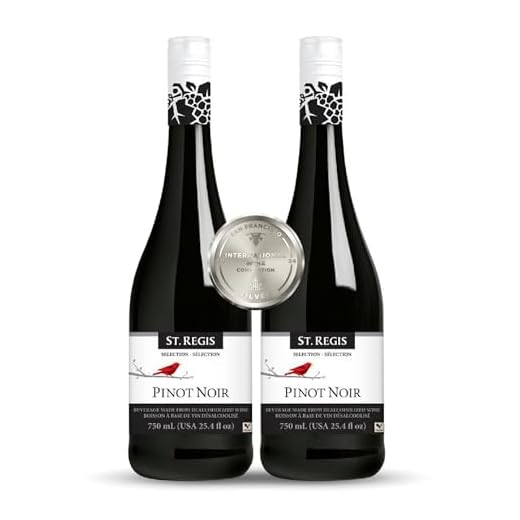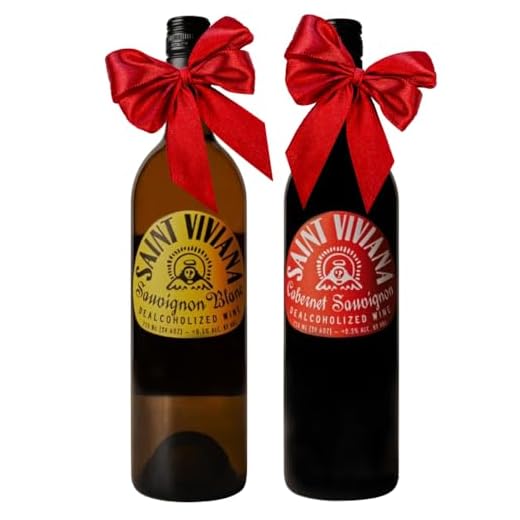



For those mindful of their sugar intake, choosing between these two types of fermented grape beverages can significantly impact your decision. Generally, the beverage made from red grapes tends to contain fewer residual carbohydrates than its counterpart made from white grapes. This difference arises due to the fermentation process and the types of grapes used.
Specifically, dry varieties of the darker beverage typically exhibit lower sugar levels, averaging around 0.1 to 0.3 grams per ounce. Conversely, the lighter option often showcases higher residual sugars, ranging from 0.5 to 0.7 grams per ounce in similar styles. If you’re aiming for a lower carbohydrate option, opt for dry red variants.
When selecting a bottle, consider the style as well. Sweet selections, whether red or white, will naturally contain higher sugar concentrations. Exploring labels and asking for specific details can help guide your choices. Ultimately, understanding these nuances allows for a more informed selection, aligning with your dietary preferences.
Which Has Less Sweetness: Red or White Varietals?
When it comes to choosing between these two types, the drier options generally contain fewer residual carbohydrates. Typically, the darker varietals, such as Cabernet Sauvignon and Merlot, tend to have lower residual levels compared to some lighter choices. If you’re looking for a drier experience, opt for those robust varieties.
Factors Influencing Residual Levels
Several elements contribute to the sweetness profile of these beverages:
- Grape Variety: Certain grape types naturally yield higher sweetness levels.
- Fermentation Process: The length and temperature of fermentation can affect how much sweetness remains.
- Winemaker’s Intent: Some winemakers intentionally leave more residual content for flavor complexity.
Recommendations for Low Residual Options
If minimizing sweetness is your goal, consider these options:
- Cabernet Sauvignon: Known for its bold flavors and typically lower residual levels.
- Sauvignon Blanc: A refreshing choice that often presents a crisp and dry profile.
- Pinot Noir: Offers a lighter body with a tendency toward drier expressions.
Always check the labels or consult with a knowledgeable seller to find the best options tailored to your palate. Enjoying these beverages while being mindful of sweetness can enhance your overall tasting experience.
Understanding Sugar Content in Wines
For those curious about the sweetness levels in their favorite beverages, knowing the details behind fermentation and grape varieties is key. Typically, the fermentation process transforms most of the natural grape sugars into alcohol. However, the residual sweetness varies, influenced by factors like the grape type and the winemaking approach.
Generally, the varieties made from darker grapes tend to have a higher concentration of natural sugars. This is due to the characteristics of the grapes themselves. Conversely, those from lighter varieties often showcase a drier profile, resulting in lower sweetness levels. This is particularly relevant when choosing a bottle for specific occasions, as the taste experience can significantly differ based on these elements.
When selecting a bottle, consider the style of the drink. Dry styles typically have minimal residual sweetness, while sweeter varieties can have noticeable levels. If you prefer a less sweet option, look for terms like “dry” on the label, which indicates a lower level of residual sweetness.
For a more precise understanding, examining the alcohol by volume (ABV) can also provide insights. Generally, higher alcohol content suggests that more sugars have been converted during fermentation, leading to a drier finish. This correlation can guide choices, especially for those aiming to reduce sweetness in their selections.
Ultimately, the exploration of sweetness levels in different beverages can enhance your tasting experience. By focusing on the grape varieties and winemaking techniques, you can make informed decisions that align with your personal preferences.
Comparing Average Sugar Levels in Red and White Wines
For those seeking options with reduced sweetness, Pinot Noir and Cabernet Sauvignon typically contain lower residual content compared to varieties like Riesling or Moscato. Here are some specifics:
- Pinot Noir: Usually has around 0.5 to 1.5 grams of residual per liter.
- Cabernet Sauvignon: Often ranges from 0.5 to 2 grams per liter.
- Riesling: Can vary significantly, often between 4 to 15 grams, depending on the style.
- Moscato: Typically shows higher levels, averaging 5 to 20 grams per liter.
When selecting a bottle, consider the style. Dry varieties, regardless of color, usually contain minimal residual content. Conversely, sweet versions will show higher levels:
- Look for descriptors like “dry” or “brut” on the label.
- Consult with knowledgeable staff at a local wine shop for recommendations.
- Taste several options to find personal preferences in flavor and sweetness.
For those mindful of carbohydrate intake, choosing wines with lower residual levels can complement various diets. It’s also beneficial to understand that the fermentation process influences sweetness; the longer the fermentation, the less residual remains. Keep this in mind while exploring different options.
Factors Influencing Sugar Levels in Different Wine Types
Fermentation duration is a primary determinant of residual sweetness in beverages. Longer fermentation typically results in lower levels of unfermented sugars, while shorter processes can leave more sweetness. The choice of grape varietals plays a crucial role as well; certain grapes naturally possess higher fructose and glucose content, impacting the final product’s sweetness.
Climate also significantly affects sugar concentration. Grapes grown in warmer regions often accumulate more sugars due to increased sun exposure. Conversely, cooler climates may result in lower sugar levels at harvest. Winemaking techniques, such as the use of oak aging or malolactic fermentation, can modify the perception of sweetness without altering actual sugar content.
Other Influential Factors
Harvest timing is vital; grapes picked later in the season can achieve higher natural sugar levels. Additionally, the winemaker’s style influences the final profile. Some producers intentionally retain more sweetness for balance and complexity, while others aim for a drier finish.
Lastly, external factors like the method of serving can affect your perception of sweetness. For instance, a chilled beverage might taste less sweet than one served at room temperature. Understanding these elements enhances appreciation and enjoyment of each unique bottle. For those interested in learning about other meticulous processes, check out how to cycle a new fish tank.
Impact of Wine Production Methods on Sugar Levels
Different production techniques significantly influence the carbohydrate content in fermented beverages. For instance, the choice of grape variety and the timing of harvesting play crucial roles. Grapes harvested later tend to have higher natural sweetness, which can elevate the residual carbohydrate levels after fermentation.
Fermentation methods also affect outcomes. Traditional methods, such as spontaneous fermentation, can lead to varying residual levels compared to controlled fermentation processes. Winemakers who utilize temperature control during fermentation often achieve a more consistent product, impacting the final sweetness.
Post-fermentation practices, such as malolactic fermentation, can further modify the flavor profile, potentially altering perceptions of sweetness. Additionally, the aging process in barrels versus stainless steel tanks influences the overall taste experience, which can mask or accentuate the perception of residual carbohydrates.
| Production Method | Impact on Residual Carbohydrate Levels |
|---|---|
| Late Harvesting | Increases natural sweetness |
| Spontaneous Fermentation | Varied residual levels |
| Temperature-Controlled Fermentation | Consistent outcomes |
| Malolactic Fermentation | Modifies flavor profile |
| Barrel Aging | Potentially enhances perception of sweetness |
In summary, understanding these production methods can guide consumers in selecting beverages that meet their taste preferences while keeping carbohydrate levels in mind. The interplay between grape selection, fermentation techniques, and aging processes creates a diverse spectrum of flavor experiences in each bottle.
How to Choose Low-Sugar Options in Wine
To identify wines with reduced carbohydrate content, focus on labels indicating “dry” or “no residual sweetness.” These terms typically signify lower levels of sweetness, which is a key aspect when selecting your beverage.
Seek varietals renowned for their naturally lower carbohydrate content. For instance, Sauvignon Blanc, Pinot Grigio, and many of the classic Italian wines are often drier. Similarly, many robust styles from the New World, such as certain Zinfandels and Cabernet Sauvignons, also offer options with minimal residual sweetness.
Reading the alcohol content can provide additional clues. Generally, higher alcohol levels (above 14%) may correlate with lower residual sweetness, as more grapes ferment into alcohol rather than remaining as sugars.
Consider the region and production methods. Old World vineyards typically produce drier styles due to different viticulture practices, whereas New World producers occasionally create fruit-forward, sweeter wines. Exploring producers who emphasize traditional techniques can lead to discovering excellent options with reduced sweetness.
Tasting notes can also guide you. Wines described as having “crisp,” “refreshing,” or “minerality” often suggest lower sweetness levels. Attend tastings or ask for recommendations to enhance your understanding of flavor profiles that align with your preferences.
Lastly, don’t hesitate to engage with knowledgeable staff at wine shops or restaurants. Their insights can help you navigate selections and discover bottles that meet your criteria while ensuring an enjoyable experience.
Health Implications of Sugar Content in Wine Consumption
Moderation is key when enjoying fermented beverages, particularly those with varying levels of sweetness. High intake of sweet varieties can lead to several health concerns, including weight gain, increased blood sugar levels, and potential heart issues.
Opting for selections with lower sweetness can mitigate these risks. For instance, a drier option generally contains fewer carbohydrates, which translates to lower caloric content. This can assist in maintaining a balanced diet and avoiding excessive caloric intake.
Metabolic Effects
High carbohydrate consumption from sweet beverages can disrupt metabolic processes, leading to insulin resistance over time. Choosing drier alternatives may help in managing insulin sensitivity and reducing the risk of type 2 diabetes.
Cardiovascular Health
Research indicates that excessive consumption of high-sugar drinks may elevate triglyceride levels, contributing to cardiovascular complications. Selecting options with minimal residual sweetness can support heart health by promoting better lipid profiles.
Incorporating lower-sweetness selections into your routine not only enhances the enjoyment of flavors but also supports overall well-being. Prioritizing these choices is a practical approach to a healthier lifestyle while still savoring the experience of fine beverages.









